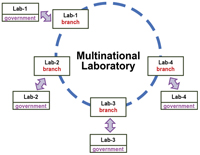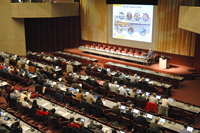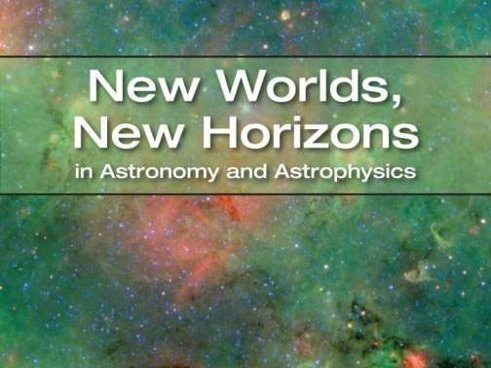White paper on Comprehensive Project Design Guidance

A conceptual supporting model of a multinational-laboratory |
Recently the International Linear Collider Steering Committee (ILCSC) published a white paper on the Comprehensive Project Design Guidance (CPDG), which describes the direction of the activity to promote ILC in its post-technical design phase beyond 2012. The document was proposed by the siting working group of the ILCSC and was discussed during the last ILCSC meeting in Paris. Now CPDG is open for comments from the community.
Read more...
-- Sakue Yamada
Research Director's Report Archive |
 |
|
|
 |
| Upcoming meetings, conferences, workshops
 International Workshop on Linear Colliders 2010 (IWLC2010)
ECFA-CLIC-ILC joint meeting International Workshop on Linear Colliders 2010 (IWLC2010)
ECFA-CLIC-ILC joint meeting
CERN and CIGC, Switzerland
18-22 October 2010
2010 IEEE Nuclear Science Symposium and Medical Imaging Conference
Knoxville, Tennessee, USA
30 October - 6 November 2010
SiD Workshop
University of Oregon, Eugene, Oregon, USA
15-17 November 2010
X-Band Structures, Beam Dynamics and Sources Workshop (XB-10)
Cockcroft Institute, Daresbury, UK
30 November - 3 December 2010
Upcoming schools
Fifth International Accelerator School for Linear Colliders
Villars-sur-Ollon, Switzerland
25 October - 5 November 2010
US Particle Accelerator School (USPAS)
Old Dominion University, Hampton, Virginia, USA
17-28 January 2011
|
|
|
GDE Meetings calendar
View complete ILC calendar
|
|
|
 |
Live from Geneva

Impressions from Geneva (click to view photo album) |
For the first time in a meeting of this scope, this year’s International Workshop on Linear Colliders in Geneva, Switzerland, brings together researchers from both of the world's major linear collider projects: the International Linear Collider and the Compact Linear Collider. Organised by the European Committee for Future Accelerators, the conference is held at CERN and at the International Conference Centre in Geneva. Scientists discuss the status of the two machines and the physics they could uncover. Break-out sessions allow scientists to exchange ideas related to accelerator and detector technologies. Our photo album shows some impressions from the first days.
View photo album
|
 |
|
|
 |
From Phys Org
19 October 2010
The promise of ion beam cancer therapy
For certain kinds of cancer, the most effective therapy does not use x-rays or gamma rays but beams of ions, the electrically charged cores of atoms, including hydrogen ions (protons) and heavier ions such as carbon and neon
Read more... |
|
From Telegraph
18 October 2010
'Telescope' buried a mile under the Antarctic ice to find source of cosmic rays
A "telescope" buried deep under Antarctic ice has detected the first signals that scientists hope will allow them to identify the source of mysterious particles that bombard Earth from outer space.
Read more... |
|
From Wired
15 October 2010
Large Hadron Collider Starts Edging Out Rivals
The Large Hadron Collider has made its first steps beyond the standard model of particle physics. With just four months of data gathered, the monster collider has already edged past the Tevatron, its particle-smashing rival.
Read more... |
|
|
 |
 |
|
|
 |
The convergence of astrophysics and particle physics

The new decadal survey for astronomy and astrophysics, Astro2010, gives high priority to particle astrophysics initiatives |
One of the more interesting and important developments in our field over the past decade has been the convergence of particle physics and astrophysics. The scope of particle physics has grown in recent years to include what we commonly call particle astrophysics, where some of the most important particle physics questions are also of high importance for astrophysics. Consequently, the new decadal survey for astronomy and astrophysics, Astro2010, which sets out the priorities for those fields in the US for the next decade, is of increased interest and importance to particle physics. This is also reflected by the growing number of highly recommended projects that are requesting support from the National Science Foundation (NSF) physics and/or the Department of Energy (DOE) High Energy Physics programme.
Read more...
-- Barry Barish
Director's Corner Archive |
 |
|
|
 |
CLIC design study
The colleagues from CLIC, the Compact Linear Collider Study, are not only busy writing a Conceptual Design Report for next year, but have also revamped their logo and website. Under
www.clic-study.org you will find all about the project, the accelerator design, the study structure, the logo and of course their slogan: CLIC here for the future!
|
|
arXiv preprints
1010.4198
Higgs boson decays and production in the left-right twin Higgs model
1010.4139
The neutral heavy scalar productions associated with ZL in the littlest Higgs model at ILC and CLIC
1010.1931
Probing Anomalous Top-Gluon Couplings at Colliders
|
|

